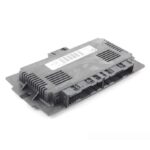The BMW M5 has always been a benchmark for high-performance sedans, and its transmission choices have played a crucial role in shaping its character. While the current F90 M5 utilizes a ZF8 automatic transmission, many enthusiasts still fondly remember the era of the DCT (Dual Clutch Transmission) in the M5 lineage. Let’s explore the evolution of M5 transmissions, focusing on the Dct M5 and why it remains a significant talking point for enthusiasts.
From SMG to DCT to ZF8: The M5 Transmission Journey
The E60 M5, the predecessor to the F90, featured the SMG (Sequential Manual Gearbox). This race-derived transmission provided a raw and engaging driving experience, with lightning-fast shifts and a distinct mechanical feel. However, its on-street usability was often criticized for its jerky and sometimes unpredictable behavior in low-speed situations.
BMW M then transitioned to the DCT in subsequent M models, including the previous generation M5. The DCT offered a compelling blend of performance and daily drivability. It delivered incredibly quick shifts, rivaling those of dedicated race cars, while also providing smoother operation in everyday traffic compared to the SMG. However, as we’ll discuss, the M-DCT wasn’t without its shortcomings.
The current F90 M5 marks a departure from the DCT, adopting the ZF8 automatic transmission. This torque converter automatic offers seamless shifts and refined low-speed manners, perfectly suited for the M5’s role as a high-performance daily driver. But has this shift to comfort come at the expense of the M5’s sporting character?
The DCT M5: Unfulfilled Potential?
While the DCT in other high-performance cars, notably Porsches, Ferraris, and Lamborghinis, reached a pinnacle of performance and refinement, the M-DCT seemingly plateaued. The consensus among enthusiasts is that BMW M could have further developed the DCT’s software and hardware to achieve the same level of smoothness and responsiveness found in competitors’ offerings. The legendary Porsche PDK, for example, sets a high bar with its incredibly quick and smooth shifts, even in demanding track conditions.
The Case for the ZF8 in the F90 M5
Several factors contributed to BMW’s decision to equip the F90 M5 with the ZF8. Cost considerations played a role, as the ZF8 was already widely used across the BMW lineup, streamlining production and reducing expenses. Furthermore, the ZF8’s inherent smoothness and reliability made it a more suitable choice for the majority of M5 buyers who prioritize daily driving comfort. The robust torque capacity of the ZF8’s single clutch also aligned well with the high-torque output of the F90’s twin-turbo V8 engine. Finally, the introduction of the M xDrive all-wheel-drive system mitigated the impact of the ZF8’s slightly slower shift times compared to the DCT, ensuring efficient power delivery in various driving scenarios.
The Loss of the “Race Car” Feeling?
The transition to the ZF8, while objectively improving daily drivability, has sparked debate among enthusiasts regarding the loss of a certain “race car” feeling. The visceral experience of the SMG and the DCT’s lightning-fast shifts contributed to a sense of connection with motorsport heritage. The ZF8, despite its impressive performance, delivers a more refined and less engaging experience. This raises questions about the future direction of M cars and whether the pursuit of comfort and broader appeal has come at the expense of the raw, unfiltered driving experience that once defined the M brand.
Conclusion: The DCT M5 Remains a Legend
The DCT M5 represents a specific period in the M5’s evolution, one characterized by a focus on raw performance and driver engagement. While the ZF8-equipped F90 M5 excels in other areas, the DCT M5 continues to hold a special place in the hearts of enthusiasts who value the visceral connection and immediate response of a dual-clutch transmission. The debate over which transmission best suits the M5 is likely to continue, but the DCT M5 will undoubtedly remain a significant part of the M5’s legacy.

